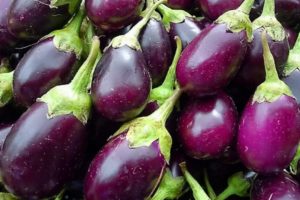TOP 15 varieties of eggplant for a polycarbonate greenhouse, cultivation and care, planting scheme
Growing and caring for eggplants in a greenhouse today is quite a lucrative business if technology is followed. This culture is fastidious, but if it is watered in a timely manner, properly fertilized, protected from pests and diseases, then it will certainly delight its owners with a good harvest.
Content
- 1 Which greenhouses are better
- 2 The best eggplant varieties suitable for growing in greenhouses
- 3 Technology for growing eggplant in a greenhouse
- 4 Landing dates
- 5 Soil and seed preparation
- 6 Soil preparation for seedlings
- 7 We grow seedlings
- 8 Planting seedlings in a greenhouse
- 9 Eggplant care in a polycarbonate greenhouse
- 10 Possible growing problems
- 11 Diseases and pests
- 12 Harvesting and storage
Which greenhouses are better
The most suitable greenhouse for heat-loving bushes is a polycarbonate sheathed structure. This material has a honeycomb structure, its air gap keeps heat well, so it is able to protect against impending frost. Enough light gets through the polycarbonate, as the transparent sheets let in large amounts of it. If the sun is shining outside, the greenhouse warms up, and this saves heating costs. If necessary, the owners of such a greenhouse are additionally insulated from the inside with an anti-condensation film.
Since the eggplant culture is small, the structure must be sized for comfortable plant maintenance. In most cases, 2.5 meters in height is sufficient. In cold climatic zones, gardeners prefer to construct greenhouses on a foundation with a 20 centimeters buried in the ground, and its frame can be either metal or wood. A prerequisite for effective greenhouses is the presence of opening windows so that it is possible to ventilate and regulate the temperature inside.
The dimensions of the structure are calculated based on the number of plants - 3-5 bushes are planted per 1 square meter. In this case, it is taken into account that the area is reduced by the thickness of the inner cladding and heating (if any).
The best eggplant varieties suitable for growing in greenhouses
Today, there are varieties that have different ripening periods, the height of the bushes, the requirements for agricultural technology. Accordingly, they differ from each other in yield, weight of fruits, their color, taste and consistency. Below will be described varieties that differ from the rest in their advantageous characteristics.
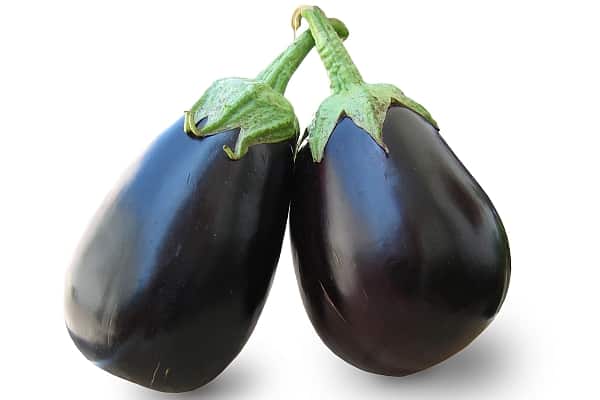
Nutcracker
The variety ripens approximately 100 days after germination. It has the following parameters:
- bush growth can reach 190 centimeters;
- fruit weight - up to 250 grams, and its length is 12-14 centimeters;
- there is no bitterness in the pulp, it is white;
- there are many inflorescences on the plants, because of this, it bears fruit for a long period and has a high yield.
A very popular and delicious variety. With proper care, up to 19 kilograms of eggplants are harvested on each square meter.
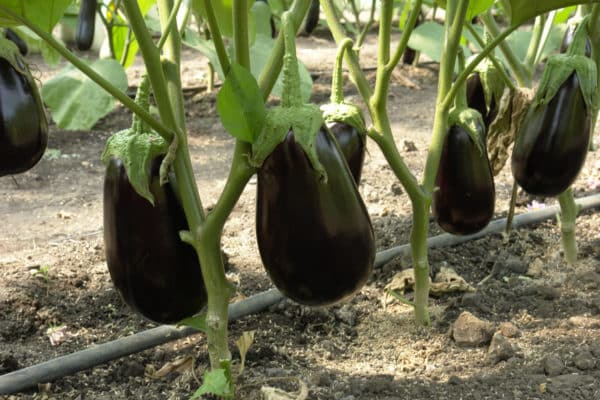
Bagheera
Fruiting begins as early as 95 days. This early ripe hybrid has the following advantages:
- these vegetables are elongated with an oval edge:
- their color is from dark purple to black:
- the mass of most fruits is about 300 grams, their length is 25 centimeters;
- the pulp is white, without bitterness;
An additional advantage of the variety is its resistance to tobacco mosaic.

Baikal
The beginning of fruiting is in 100-110 days. Characteristics of this mid-early hybrid:
- the plant is tall and reaches 2.5 meters;
- fruits of medium size, their weight ranges from 300 to 400 grams;
- eggplant with a dark purple tint;
- the pulp is green, the structure has a high density.
These bushes need to be tied up. The landing pattern is 40x60 centimeters, and up to 6 kilograms are collected from one square meter. This variety is also resistant to tobacco mosaic.
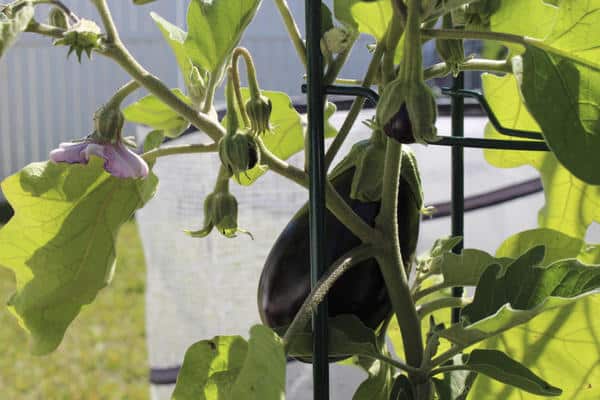
Joker
This eggplant is early maturing (85-100 days), it is distinguished by the carp type of fruiting. The following advantages are:
- plant height in a greenhouse - from 1 meter;
- the number of fruits on one bunch - 3-7 pieces;
- eggplants are elliptical;
- fruits are bright pink with a glossy surface;
- the pulp is very tender and juicy, the skin on the vegetable is thin;
- its taste is slightly bitter.
In addition to the listed characteristics, this eggplant has an increased resistance to dropping of ovaries. One plant can grow up to hundreds of fruits.
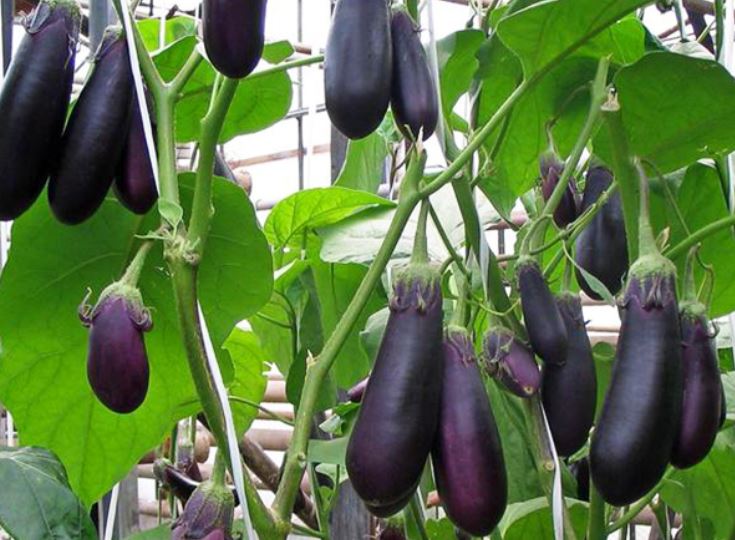
Purple Miracle F1
This eggplant variety begins to sing on day 110 after germination. It has the following characteristics:
- the height of the bushes can reach 75 centimeters;
- his fruits are cylindrical;
- color of vegetables - from dark purple to black;
- the length of eggplants ranges from 15 to 18 centimeters, and their diameter reaches 8 centimeters.
A feature of the variety Violet Miracle F1 is that there is no bitter taste at all. This eggplant sets fruit even in temperate climates and is also resistant to spider mites.

Fabina
Fabina's eggplant culture is considered ultra-early, because it manages to start bearing fruit after 50 days. In addition, it has the following characteristics:
- sprawling plant;
- can grow up to 60 centimeters;
- it forms up to 9 fruits per bush.
In addition, this variety does not require the creation of supports and tying for it.
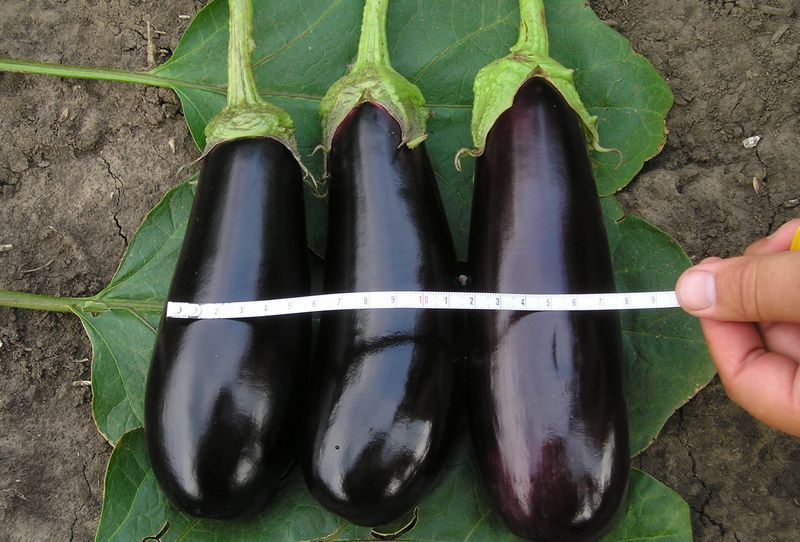
Black Moon
The growing season before fruiting is 110-115 days. In addition, the variety has the following description:
- the skin of the eggplant is glossy, dark purple in color;
- the weight of most fruits reaches 250-350 grams;
- inside the pulp is light green, there are no bitterness and voids.
The yield of the variety reaches more than 5 kilograms per square meter. Plants have an increased resistance to tobacco mosaic. This eggplant has excellent taste.

Sophia
This eggplant is an early maturing and fruitful hybrid. Its additional characteristics are as follows:
- bush height - from 45 to 60 centimeters;
- has fruits of dark purple color, shiny;
- cylindrical shape;
- its peel is thin, there are few seeds;
Also, the variety is suitable for transportation and long-term storage.
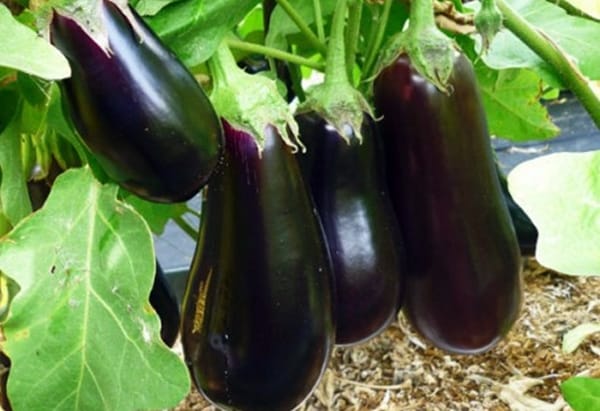
Black handsome
The fruits of this variety ripen in 110 days. Description of this eggplant:
- bushes grow up to 80 centimeters high;
- weight ranges from 200 to 900 grams;
- fruits are black-violet, with shiny skin;
- a high-yielding variety (from 1 square meter, up to 9 kilograms can be harvested).
The variety has an average cold hardiness, therefore it is recommended exclusively for greenhouses.

Alenka
Eggplant culture that reaches 105 days later. Characteristic:
- a variety of medium height - 70 centimeters;
- fruits are light green, cylindrical;
- their weight is about 350 grams, length - up to 15 centimeters;
- the yield of the variety is high.
The pulp of these vegetables is tender and completely devoid of a bitter taste. In the open field, the fruits become smaller.
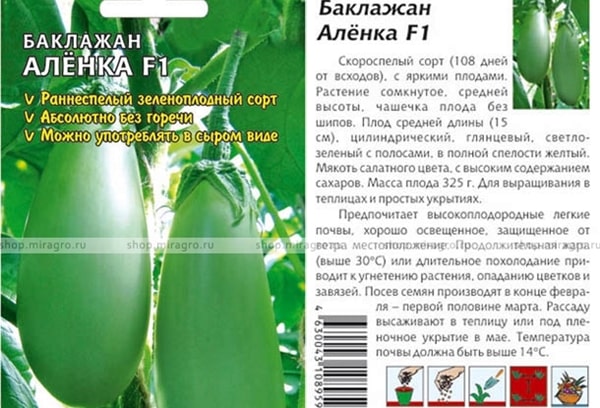
City F1
The variety is a mid-early hybrid (it starts bearing fruit after 120 days). Additional description:
- the bush is tall - it reaches a length of 180 to 300 centimeters.
- the fruits of these eggplants weigh up to 500 grams;
- the skin on vegetables is shiny, dark purple;
- the consistency of the pulp is dense, and the shade is light green.
- the shape of the fruit is cylindrical.
These plants need to leave 2 shoots each and tie them up. An eggplant hybrid Gorodovoy is capable of showing resistance to tobacco mosaic.
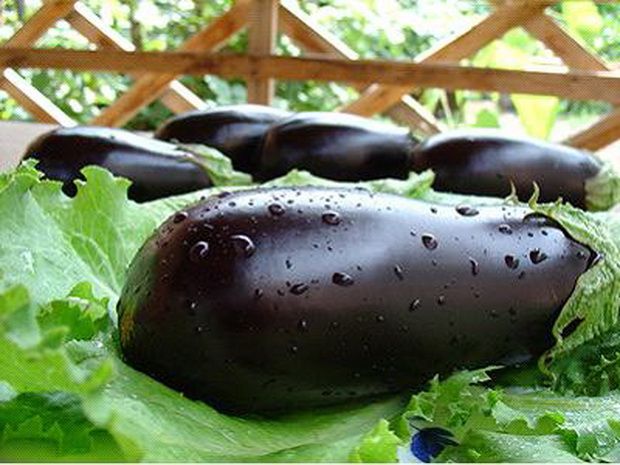
Technology for growing eggplant in a greenhouse
In order to achieve active fruiting, in addition to the selection of suitable varieties, the gardener must know the secrets of preparing a greenhouse for eggplants and the rules for growing this crop.
Prepare the greenhouse like this:
- They clean the area from all unnecessary. They are removing last year's stakes, ropes, inventory. Take organic residues out of the greenhouse.
- Check the condition of the supporting structure and cladding.
- The inside of the greenhouse is washed with warm water and detergent.
- Treated with a steam generator or lime with chlorine.
- All chemicals are washed off with clean water.
- If necessary, light sulfur bombs.
After the above-ground part of the greenhouse is put in order, you need to take care of the soil. It will also have to be disinfected. To do this, take a weak solution of potassium permanganate (as an option, copper sulfate, Fitosporin or Fundazol can replace it) and water the soil surface. After a while, they are dug up with organic matter.
It is necessary to properly grow eggplants, observing the planting dates, growing seedlings from seeds, caring for the plants in the greenhouse.
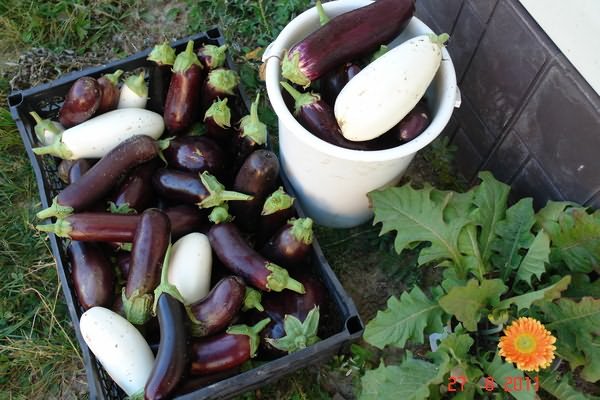
Landing dates
You can figure out when it is best to plant the plants using the calculation.
- Seedlings need to grow until the moment of planting at least two months from the period of emergence.
- Eggplants are transferred to an unheated greenhouse only after the temperature has stabilized. For the middle lane, this is late spring and early summer. Therefore, seeds are sown in February-March.
If the greenhouse is heated, then eggplants are already sown in the last decade of January, and grown seedlings are planted in April. This option is not cheap, so you need to first assess the profitability of growing eggplant.
For regions such as the Moscow region, the planting date falls on May 10, and where the climate is even harsher, the process of growing eggplants in a greenhouse is delayed at a later time.
Soil and seed preparation
Quality seeds are the key to success when harvesting from an eggplant crop. But before sowing plants, one must not forget about disinfection and filling the soil with useful substances.
If the seed is collected with your own hands, then it is advisable to disinfect it as well. A slightly pink solution of potassium permanganate is suitable for this, in which it is kept for a third of an hour. After that, they are washed and placed in ash diluted with water. The seeds should stay in this nutrient solution for a day - this procedure increases the percentage of their germination.
Then they are taken out and wrapped in a damp cloth for another day. During this time, the seeds will already hatch. And if you use this method of preparing seed material, then the seedlings will be in 5 days. In other cases, you need to wait for the emergence of young plants for two weeks.
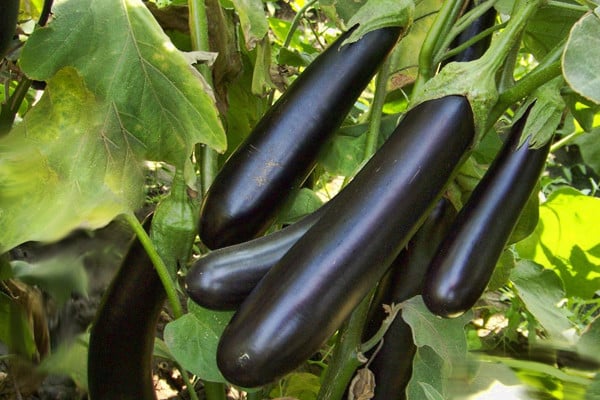
Soil preparation for seedlings
In order for the soil to meet the requirements and have the proper degree of nutritional value, it must be prepared:
- A suitable composition is prepared.It's good if there is enough organic matter and it has high breathability. Most often it is combined from the following components: compost, garden or leaf soil, sand and ash.
- To obtain uniformity, it is sifted through large sieve meshes.
- Then the soil is disinfected. To do this, it is kept in an oven for about half an hour at a temperature of 40 ° C. Alternatively, you can steam it in a water bath.
If desired, you can purchase a ready-made substrate in a specialized store.
We grow seedlings
As soon as shoots appear, the temperature for young plants is kept at 22-23 ° C during the day, and 16-17 ° C at night. Watering is carried out only with settled water, once every 5 days.
If such a need arises, then the seedlings are fed with potassium nitrate. To do this, take 1 teaspoon of the substance for half a bucket of water. At the same time, the soil is irrigated with this solution so that the fertilizer does not fall on the plants themselves.
When 2 real leaves appear on each plant, then a dive is carried out - they are seated one by one in each glass. In this case, the seedlings, in comparison with how they grew before, deepen to the cotyledonous leaves.
In order for the seedlings to develop properly, they need at least half a day of daylight hours. Therefore, gardeners use fluorescent lamps.
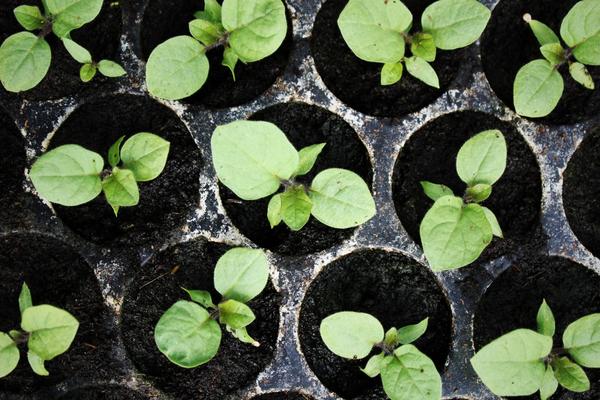
Planting seedlings in a greenhouse
Each vegetable crop differs from others in the size of the root system and the size of the bushes. And so that there is no competition between eggplants for light and nutrients, the planting scheme must be chosen correctly, otherwise the crop yield will decrease.
Yes, these plants have an increased demand for development conditions, but the gardener can finally determine the distance when he knows which varieties will grow in the greenhouse.
As you can see from the description, the parameters of different types of eggplants differ significantly. For small specimens, the optimal distance in a row is from 30 to 45 centimeters. The distance between the rows can be up to 50 centimeters. Sprawling - 50 centimeters in a row and 65 in aisles.
Eggplant care in a polycarbonate greenhouse
The technology of growing in a greenhouse has enough differences in comparison with care in the open field. A polycarbonate greenhouse has its own microclimate, which, on the one hand, contributes to the development of eggplants (more heat), and on the other hand, affects them negatively (air stagnates, humidity is higher than normal, condensation forms on the walls). Therefore, the gardener's task is to maintain the advantages of growing conditions and minimize disadvantages.
How to maintain a comfortable temperature
It is difficult to find a plant that would react to temperature conditions as sensitively as an eggplant. This is due to the fact that the inflorescences are pollinated and the fruits are tied only with sufficient heat. The plant feels comfortable at 25 ° C warmth. If it drops below 15 ° C, then the bushes can stop growing, and when, on the contrary, it rises to 35 ° C, pollination and the appearance of future fruits stop. Therefore, it is imperative to control the amount of heat.
This is done using 2 thermometers. One of them is placed at the top of the structure, and the other in the soil.
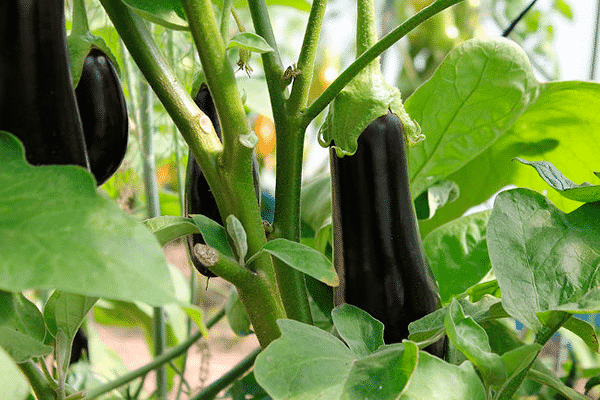
To lower the temperature, gardeners perform the following actions:
- ventilate;
- cover the outer surface of the greenhouse with a shading material;
- spray it with water and chalk;
- watered inside the track.
Watering
Since eggplant is a somewhat picky culture, it is advisable not to use tap water for watering plants right away. These bushes need water at room temperature. If eggplants are watered cold, they will experience a shock.
When watering, the liquid should enter the soil by at least 20 centimeters, where the root system of this vegetable crop is located. Gardeners irrigate only the ground around the eggplants, and they are left dry to avoid the occurrence of fungal infections. Moisten the soil early in the morning, 1-2 times a week. The best invention used in a greenhouse is drip irrigation.
Top dressing
Fertilize eggplants in the greenhouse 3 to 5 times per season. Today, the most relevant are complex fertilizing: Kemira, Solution. These preparations for 10 liters of water add 1 ½ tablespoons.

If the period of formation of future fruits has begun, then a nitrogen-phosphorus solution is introduced into the soil, which has 1 teaspoon of ammonium nitrate and 1 tablespoon of superphosphate fertilizer in one bucket of water.
Organic matter, although it works well for the growing season, can only push eggplants to build up green mass. It is advisable in such cases to use the Biud complex fertilizer, which is diluted 1:20.
Bush formation
This important step in eggplant care is not shown to all varieties. They form only tall and medium vigor plants, and a low-growing vegetable crop does not need this. Therefore, dry leaves and those that block the sunlight from the ovaries are cut off on compact eggplant bushes.
The rest of the varieties begin to form 14 days after planting in a permanent place of growth. If the plant is depressed, then he is given a week or two extra time without this procedure.
There are several options for performing shaping:
- In 1 stem. It is used for thickened plantings. When forming up to 4 leaves, lateral branches and inflorescences break off. At a height of 8 leaves, the stepsons are removed, and some of the future fruits are left. After 10 leaves, branches with an ovary are left.
- In 2 shoots. When the eggplant reaches a height of 30 centimeters, then remove its top. After the growth of lateral branches, the 2 most developed of them are left, and the leaves located below are cut off. Then the stepson are timely.
- 3 stems. They do everything in the same way with the previous option.
All tall eggplant varieties are tied to supports.
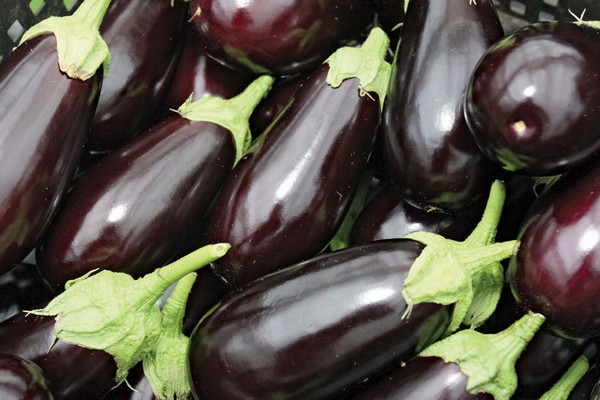
Pollination
Eggplant has flowers of both sexes on one plant, and pollination can occur independently. Unfortunately, there are no corresponding insects in greenhouses, and gardeners, in order to increase the productivity of plants, have to slightly move the bushes.
Airing
When ventilating greenhouses and hotbeds, open windows, transoms and doors. But they do it on the one hand, so that there are no drafts, since they are harmful to eggplants. In greenhouses with two entrances, only one of them is opened to avoid turbulence.
Airing makes it possible to reduce temperature and humidity in greenhouses.
Possible growing problems
Often, gardeners during the cultivation of eggplants experience the following difficulties:
- Leaves change color from green to yellow. This is due to a violation of the timing of watering or incorrectly applied top dressing, and maybe because of a disease.
- Falling flowers. The reasons for this phenomenon lie in the deficit or excess of water in the soil.
- Do not want to set fruit. One of the reasons is the lack of pollination, excessive feeding or the absence of formative pinching.
- Burns on the green part of plants. This problem occurs due to direct sunlight.
- Twisting of leaf plates on bushes. The reason may be excess moisture or lack of light, and possibly pests.
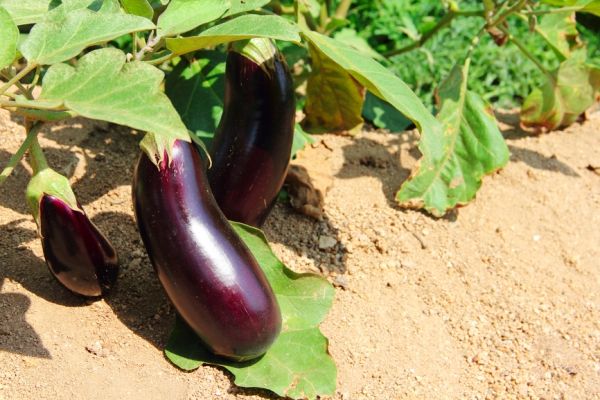
Diseases and pests
Unfortunately, harmful insects and diseases can appear on eggplants not only if they are improperly grown in greenhouses. Therefore, before treating plants with any chemical means, it is necessary to establish what disease or insect caused this state of eggplant.
When buying a specific drug to get rid of a specific lesion, read carefully and strictly follow the instructions.
Most often, eggplant culture, due to high humidity, can get sick with fusarium, gray rot, late blight, and sometimes a spider mite appears.
In order to be more likely to grow healthy eggplants, preventive measures are taken:
- before sowing, the seeds are treated, in the case of their own collection;
- disinfection of soil when growing seedlings;
- good care of the eggplant culture in the greenhouse at all stages of the growing season;
- replacement of the top layer of soil after harvest;
- creating the right microclimatic conditions in greenhouses;
- systematic examination of eggplants for the absence of dangerous insects and diseases;
- thorough weed removal;
- correct application of dressings;
- adherence to watering and ventilation regimes, in order to avoid excessive dampness and dryness.
Breeders are also working on an abundance of future harvests, they are creating varieties that will have even greater resistance to diseases and pests.
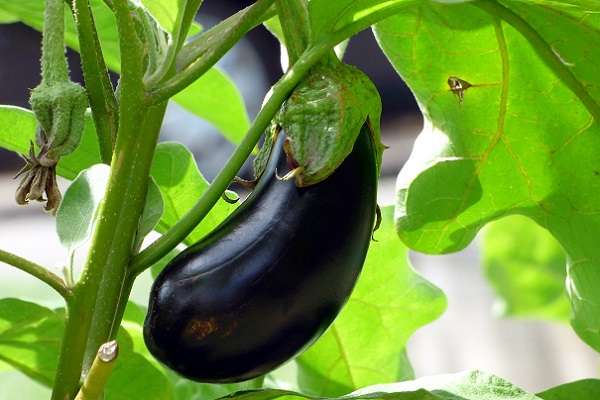
Harvesting and storage
Harvested when they acquire technical ripeness. Usually it occurs 25-40 days after the flowering of the bushes. Fruit color may appear before they ripen. The first sign that a vegetable has already reached is the degree of firmness of the pulp. Check it by pressing the fruit with your finger. This creates a dent on the eggplant, which will heal in a few minutes. The vegetables that have reached are cut with a secateurs. This leaves a small tail.
Store eggplants in a cool dark place. To do this, they are placed in boxes in 2 balls, shifting with straw or parchment paper. Every 14 days, revise for rot. Those vegetables that have undergone changes are removed from the box.
Since eggplants are picky plants, growing them is not easy. But those vegetables that you can buy in stores can in no way compare to those that are grown on your own. Therefore, you just need to carefully apply the necessary agrotechnical measures and be patient. The time will come when eggplants will delight their owners with a wonderful harvest.

